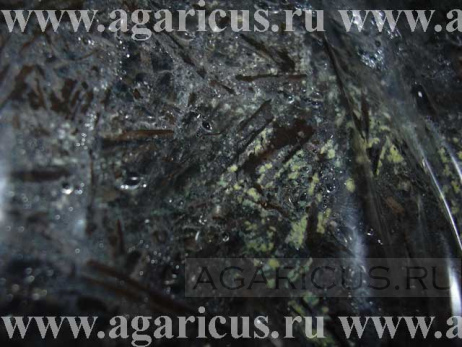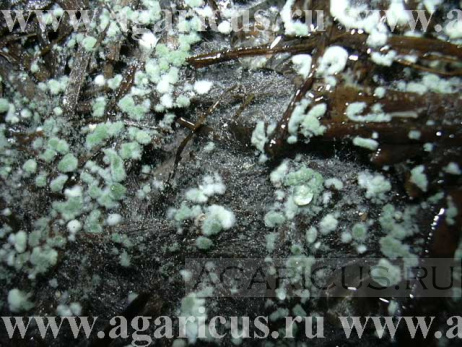Olive green mold
Chaetomium spp.
Olive green mold is seen pretty often. In its presence in the compost, the reduction of mushroom yield happens proportionally to the degree of the mold growth. When compost is severely infected and the mold rigorously grows in it in a short period of time after pasteurization, a satisfactory yield cannot be expected.
Olive green mold in a bag of compost
Olive green mold in the compost on its initial stage
The olive green mold mycelium is grayish-white in color and it can be mistaken for mushroom mycelium on an early stage of growth. After some time, fruit bodies the size of a pin and the shape of olive green pustules appear on the white, fluffy mold. They darken in time, and the compost in these areas becomes black and smells musty and damp. Olive green mold can appear on the casing surface or inside it. There’s also a kind of Chaetomium mold creamy and grey in color. Spores, which form on pustules, are easily carried by wind, insects, personnel’s clothes and other objects.
Olive green mold progressing in the compost
Olive green mold serves as an indication of low quality compost. The main reason for its appearance is the remaining amounts of ammonia after pasteurization or newly formed ammonia.
Ammonia can remain in the compost:
Olive green mold is seen pretty often. In its presence in the compost, the reduction of mushroom yield happens proportionally to the degree of the mold growth. When compost is severely infected and the mold rigorously grows in it in a short period of time after pasteurization, a satisfactory yield cannot be expected.
Olive green mold in a bag of compost
Olive green mold in the compost on its initial stage
The olive green mold mycelium is grayish-white in color and it can be mistaken for mushroom mycelium on an early stage of growth. After some time, fruit bodies the size of a pin and the shape of olive green pustules appear on the white, fluffy mold. They darken in time, and the compost in these areas becomes black and smells musty and damp. Olive green mold can appear on the casing surface or inside it. There’s also a kind of Chaetomium mold creamy and grey in color. Spores, which form on pustules, are easily carried by wind, insects, personnel’s clothes and other objects.
Olive green mold progressing in the compost
Olive green mold serves as an indication of low quality compost. The main reason for its appearance is the remaining amounts of ammonia after pasteurization or newly formed ammonia.
Ammonia can remain in the compost:
- when pasteurization is carried out in a very short period of time;
- at high fluctuations in temperature during the pasteurization process;
- at insufficient aeration during pasteurization;
- at a very high temperature of pasteurization (above 62°C);
- when anaerobic conditions are created during pasteurization because of a high compost filling consistence or an excessive humidity of phase 1 compost;
- at the application of an excessive amount of nitric supplements, especially ammonia sulfate and urea;
- when poultry manure of low quality is used (in big clumps) and when the mixture is poorly mixed at compost preparation.
- the compliance by the technology and the preparation of high-quality phase 1 compost with a good structure, normal humidity level and balanced C/N ratio;
- carrying out compost pasteurization properly;
- maintaining hygiene on the farm.




Lko:
Saheb hamare mushroom dry bable se pura form doob chuka hai ismein Ham Kya Karen Sahab Koi upay Ho to...
Production of Compost, Personal opinion (part 3). Wet...Abimbola Olaniyi-Balogun, Lagos Nigeria:
Hello there, I made mushroom compost using the long composting method. I used wet chicken manure, fresh...
Mushrooms in KazahstanZagreb, Croatia:
My name is Zlatko Vidmar.
Without chicken manure compost? Yes, it's possible...I am in modern mushroom growing over 40 years.
I see your farm and if...
nanyuki:
my email is samuelnjogo@gmail.com
Without chicken manure compost? Yes, it's possible...nanyuki:
i want to learn like a child on compost making for mushroom
Mushrooms in KazahstanVELLORE TAMILNADU INDIA:
SUITABLE JOBS – MUSHROOMS GROWER / COMPOST / SPAWN OR RELAVANT FIELDS
Without chicken manure compost? Yes, it's possible...Dear Hiring Manager...
Patna:
PLEASE SEND YOUR FORMULA without-chicken-manure-compost
watering first flush mushroomswasil, Malaysia:
i suggest you not to water on mush just maintain the good humidity if you not have any auto system for...
Compost Production. Personal opinion (Part 2)NARENDER SEHRAWAT, FARIDABAD NCR:
COMMON PROBLEM IN PHASE 1 BUNKAR IS THE UNBALANCED TEMERATURE, IT STARTS FROM 50-55 DEGREES TO 78-82...
Without chicken manure compost? Yes, it's possible...Hannes, Plettenberg Bay, South Africa:
Can you give me more details on compost without chicken manure for mushroom growing, what alternatives...